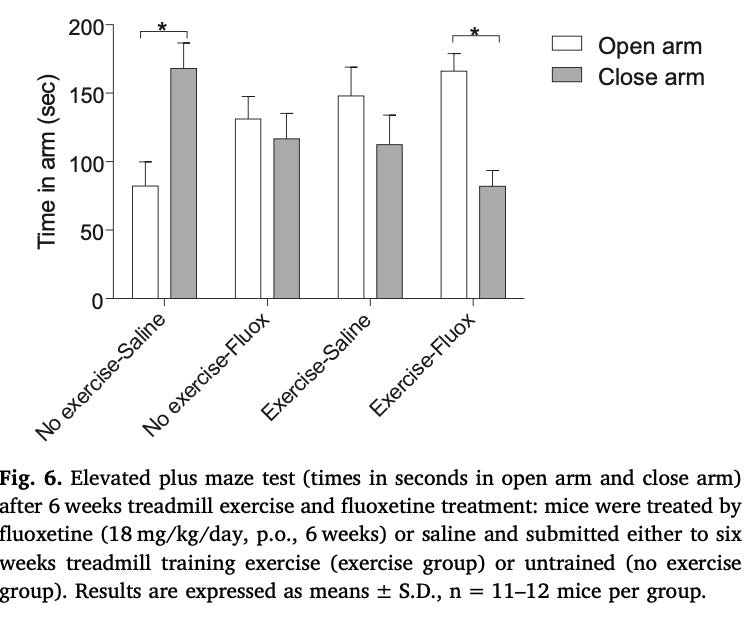We kick off this series on the real truth about SSRIs by making the seemingly wild observation that Prozac is a performance-enhancing drug in mice.
It synergizes with exercise to build muscle and grip strength, and it builds endurance capacity in couch potatoes.
Does this mean you should take Prozac? Absolutely not. I wouldn’t touch this stuff with a 14,000-foot pole.
But what it does mean is that if your doctor thinks SSRIs are primarily psychiatric drugs, your doctor does not understand SSRIs.
If you think SSRIs are primarily moderating your mood, you do not understand SSRIs.
Forty-eight mice were divided into four groups: a six-week treadmill-based exercise program with Prozac or a saline placebo, or a six-week sedentary period with Prozac or a saline placebo. The Prozac was administered orally in the drinking water at 18 milligrams per kilogram body weight, which is the equivalent of a human taking 1.46 milligrams per kilogram body weight. The doses used in humans are 10-60 milligrams per day for ages 8-17 and as high as 80 milligrams per day in adults. For a 55-pound, 8-year-old female, this is 0.4-2.4 milligrams per kilogram bodyweight. For a 154-pound adult, this is 0.14-1.14 milligrams per kilogram bodyweight. Thus, the mouse dose is equivalent to a relatively high dose given to a relatively lower-weight individual.
Prozac increased the growth of the calf muscles in the mice that exercised:
While only the Prozac+exercise group gained statistical significance, this is probably because the study is statistically underpowered to detect the synergy. If you just look at the tops of the bars, they increase as you go from sedentary alone to sedentary with Prozac, from sedentary to exercise, and from exercise alone to exercise with Prozac.
The synergy was much more powerfully demonstrated for grip strength:
On the other hand, Prozac acted as a mediocre and inferior substitute for exercise on aerobic metrics.
This was true for maximal aerobic velocity:
And for time to exhaustion:
However, I don’t quite trust the lack of synergy here. The time to exhaustion graph looks like there is an exercise+Prozac interaction that is smaller than the effects of exercise alone or Prozac alone but might nevertheless be real and not statistically significant due to lack of statistical power. For the impact on maximal aerobic velocity, it may well be that exercise maxxed out this metric and there was nothing else to do for Prozac, but I do wonder whether we would have seen different results if the mice on the exercise program were given a deload week for maximal recovery prior to their big competition.
Prozac also increased the VO2max of the mice who exercised:
Now, you may think that the mice just grew bigger muscles and gained more grip strength because they were happier (LOL) and therefore just worked out harder.
Then you can preserve the mythology that SSRIs are primarily psychiatric drugs acting on mood.
But as it turns out, exercise considerably outperformed Prozac in improving the mental health of the mice.
The behavioral tests they ran are primarily tests of anxiety rather than depression. However, these tests tend to correlate with one another in mice, so the authors are somewhat justified in considering these measures of “anxio-depression.”
Mice that have less anxiety and depression spend more time in the center of open field tests and in the open arms of elevated plus mazes.
Exercise alone was more powerful than Prozac alone in increasing time spent in the center of open field tests:
When the time spent moving within the center was compared to the total time spent moving, the impact of Prozac alone lost statistical significance and only the impact of exercise was statistically robust:
Once again these look like there is a Prozac/exercise interaction and the statistical power is too low to detect each comparison.
However, it remains the case that exercise is a more powerful antidepressant than Prozac.
For the elevated plus maze we want to see higher white bars, and once again it looks like there is a Prozac/exercise interaction but Prozac is more powerful than exercise and the statistics are underpowered:
If we compare the performance-enhancing effects to the behavioral effects we can say this:
Exercise provided a more powerful antidepressant effect than Prozac.
Prozac produced more growth of the calf muscle than exercise.
Prozac produced a nearly identical and additive boost in grip strength.
Especially on strength and muscle growth, the effect of Prozac is clearly separated from its antidepressant effect.
None of this is meant to say you should use Prozac for performance enhancement. You should apply the same skepticism to this as you should toward injecting synthetic cattle hormones into your butt to build muscle.
Rather, the point here is that SSRIs do not do what you think they do. As we move along in this series over the course of this coming week, all of this will make much more sense.
The take-home points for now are these:
Pharma has no idea what they are drugging you with.
SSRIs don’t do what your doctor thinks they do.
Serotonin isn’t whatever you think it is.
Read the next installment here:
Melatonin Is Your Mitochondria's Guardian Angel
As our story moves on from the first installment in our journey toward understanding why Prozac is a performance-enhancing drug, why people who use SSRIs often develop sexual dysfunction, and why people who quit SSRIs can feel electric shocks running through their head as if they were trying to exit a relationship with an abusive partner with an electri…











They do damage to the mito
So appreciate you sharing this - so many questions - can’t wait to read your further thoughts on this